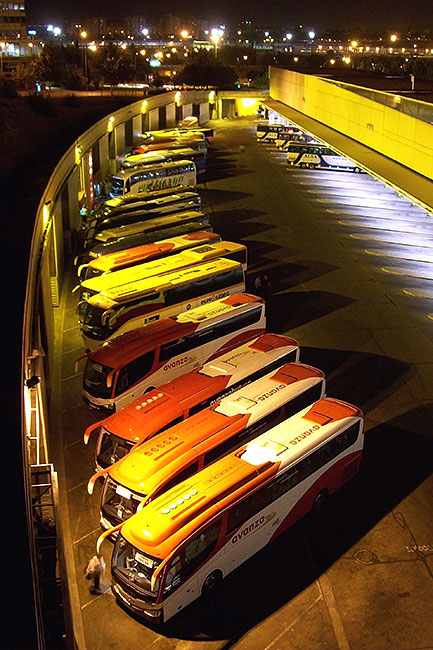About Madrid buses I have remained mostly silent, despite this blog’s fetishistic name and despite many past gushes about Madrid’s rail network.
Why?
Blogger bias! Blogger emotional bias. I lived without wheels for over a decade in car-centric Los Angeles, may suffer a straphanger’s PTSD from so many occasionally torturous slogs in buses there, as confessed in a 2018 post. To a transplanted Californian, Madrid’s metro is still a great luxury.
But, not everyone feels as I do. I know some Madrileños who prefer bus transit. They like to sightsee, to travel without hurry. One sees the metro as dark, crowded, vaguely forbidding. Another flabbergasted me by perceiving a status differential in favor of bus travel. (!!) The riffraff are likelier to ride the metro, in J.’s eyes, the gentuza; these subterranean fulanos, menganos, zutanos y perenganos squat indecorously on wagon floors; some blare music without ear buds. One may encounter panhandlers, even pickpockets. He sees himself as more civilized while riding at street level, secure in his proximity to the professional bus driver, who would presumably scold or eject riders behaving loutishly.
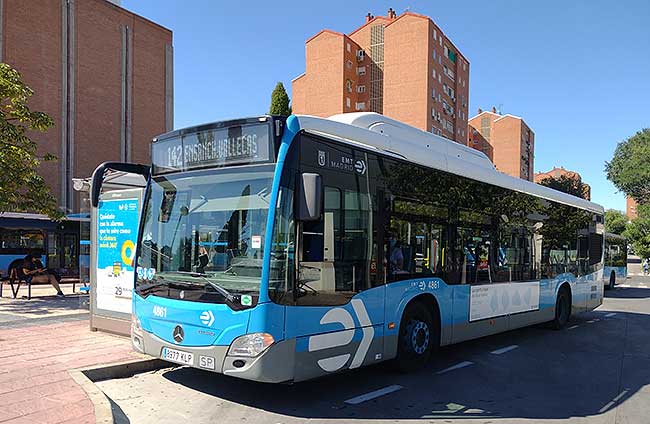
(J.’s views, I emphasize, and not mine. I still have my Madrid Metro coffee mug and refrigerator magnets.)
Madrid’s bus network is far more complex and intimidating than its rail grid, inherently and unavoidably. The metro is comprised of sixteen lines, including Metro Ligero and the Ópera-Príncipe Pío shuttle. The Cercanías commuter rail offers twelve. The bus grid, in contrast, includes hundreds:
(♦) buses serving only the city of Madrid, operated by EMT;
(♦) buses serving other municipalities (Getafe, Parla, Leganés, dozens more) in the greater Madrid comunidad;
(♦) interurban buses connecting Madrid city to these municipalities;
(♦) long-distance, beyond-the-comunidad buses;
and, finally:
(♦) a smorgasbord of long-distance bus routes operated by Alsa, Avanza and other private sector companies, that serve Madrid but are only described on the company web sites.
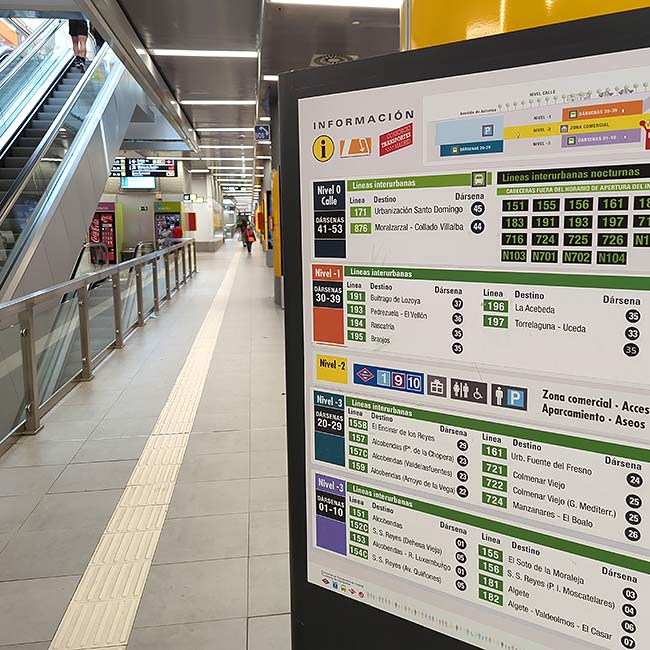
Complicated! I’m still partial to one Madrileño’s overview, expressed to me in A2 English in an intercambio chat in 2016: “The metro,” he said, “you get for free.” (Not in price, but for simplicity.) “For the bus, you have to work.”
The most impressive feature of this colossal grid may be the brawny intercambiadores, or bus/rail transit hubs. Join me in gazing wondrously at the web page of one of the largest: Moncloa, which hosts two metro lines and over seventy bus routes. The Moncloa hub includes convenience stores, eateries, a CRTM Tarjeta Transporte Público office, ticket outlets for long-distance rides from Alsa and Avanza, tidy restrooms and, finally, a general information booth. Signs like the one above (photographed at another intercambiador, Plaza de Castilla) invite one to ascend or descend escalators in search of one’s departure dársena.
Dársena = dock, or gate. The Plaza de Castilla shot below is representative. I snapped it before boarding a 724 bus to the Manzanares castle. One queues (politely, J. would expect, the better to be differentiated from the knuckle-dragging savages like me who shed fur and slobber n’ drool whilst gnawing on grab rails in the underground); the driver opens the door; passengers continue to the bus. The green 724 navigated a labyrinth of underground tunnels before emerging at street level.
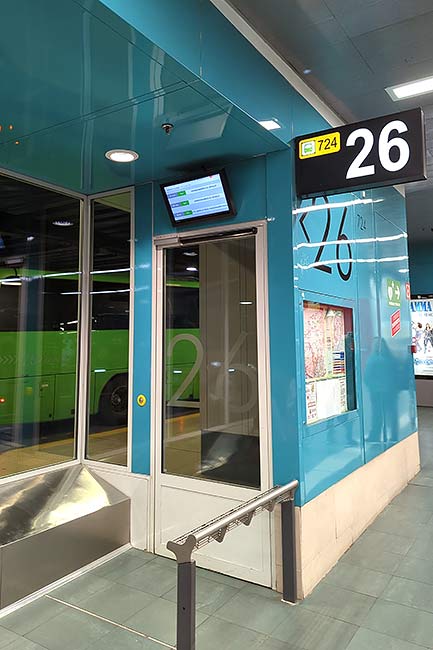
At street level throughout city and comunidad one also will encounter a sinfín of conventional curbside bus stops, as in Los Angeles, San Francisco and, I suppose, most cities worldwide. Each bus stop has a number. The twenty-first century straphanger may plug this number into the internet resource of choice to learn what buses will stop there and when they’ll arrive. I am enamored of a Telegram bot, but there are web sites, apps, and, for those unconcerned about life under the umbrella of Alphabet’s de facto global surveillance system, the consistently excellent transit directions provided by Google Maps.
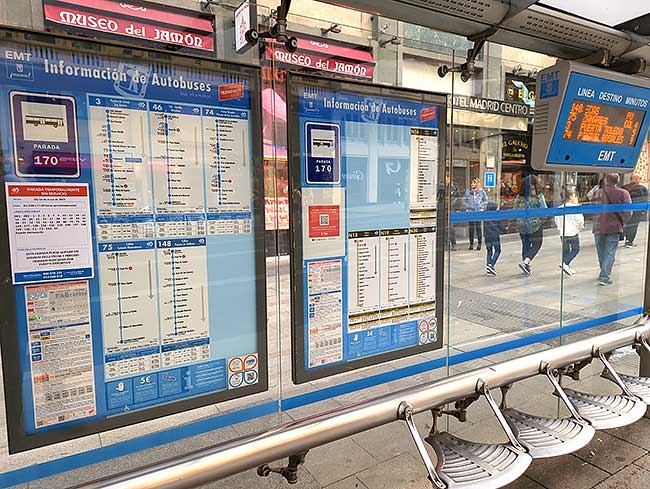
(Incidentally: nothing prevents the curious from plugging Madrid bus stop ID numbers into an online resource and comparing the number and frequency of arrivals to the equivalent in S.F. and L.A., as stops in these California cities are numbered, too. Please don’t forget the nine hour time difference.)
How well does Madrid’s bus infrastructure work? Quite well, say those I’ve queried. I’ll say so, too, although my experiences are limited, and authorship of this post won’t woo me from my beloved subway. I expect Madrid buses to be modern, clean, punctual and to have a seat for me (although I have ridden rarely at rush hour). That’s saying a lot. Consider the cleanliness of the intercambiadores in this post’s photos. Like landside airport terminals.
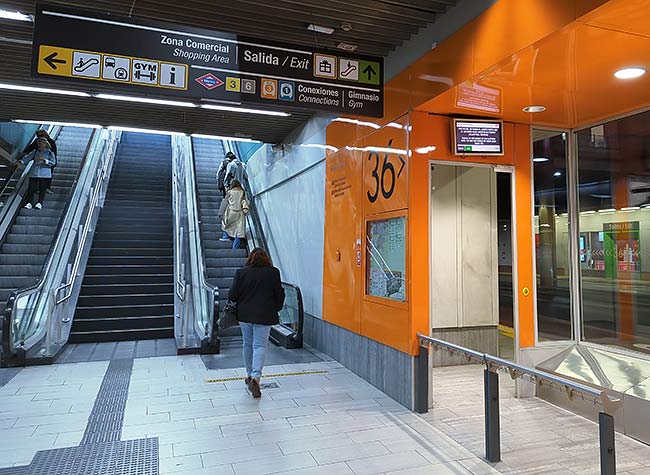
‘Expectation of quality‘ is a nebulous term for comparing transit systems, but this is still the phrase I want to use when contrasting Madrid bus transit to what I remember in L.A. and S.F. ¹ The Madrid transit rider is emphatically not a second class citizen. One’s boss or department head may travel by transit, and certain normas no escritas suggest that this eminence will endure only so much slumming in a daily commute.
Consider one’s minimum expectations for an economy-class commercial shuttle flight between cities, the experience expected in the airport and on the plane. The Madrid transit rider’s experience is certainly below that level, but not so far below that the comparison seems absurd. (Except on some jammed Madrid metro lines, perhaps particularly the 1.) In contrast, the same comparison to the transit I remember in San Francisco and Los Angeles feels preposterous, ridiculous.
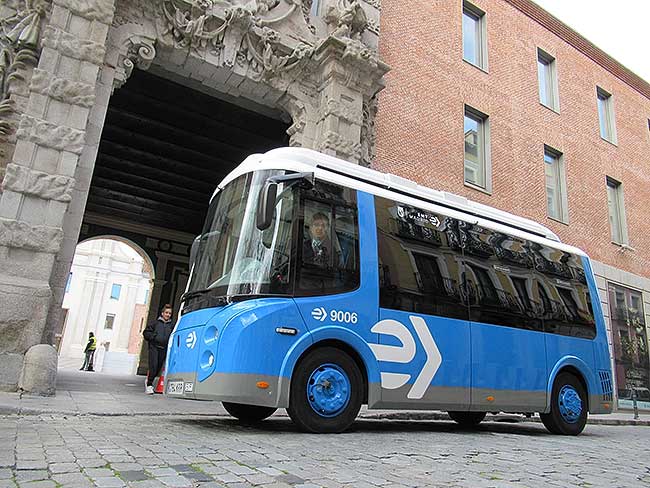
Do Madrid bus services offer takeaways for the United States? They certainly could, but your cynical blogger also sees an opportunity to hype a starry-eyed project with little likelihood of implementation in the auto-obsessed U.S.. (As in, ‘Let’s convince so-and-so to bankroll our “exploratory survey” to Spain, so we can quaff calimochos for a week on their dime before writing a glossy report that will be clucked over for awhile before being frisbee’d into the circular file.’) I suppose realistic prospects would depend on the functionality of the transit agency, the readiness/determination of its community shot callers to follow through and the resistance those shot callers would encounter along the way. I have depended on American transit long-term only in San Francisco and Los Angeles, and lack a sense of the lay of the land elsewhere. The U.S. is home to many more big cities with traffic and pollution issues.
¹ Edit, 5/18/23: Although likely not today.
Lead photo: Buses at Méndez Álvaro intercambiador, CC BY-SA 3.0, Luis García
